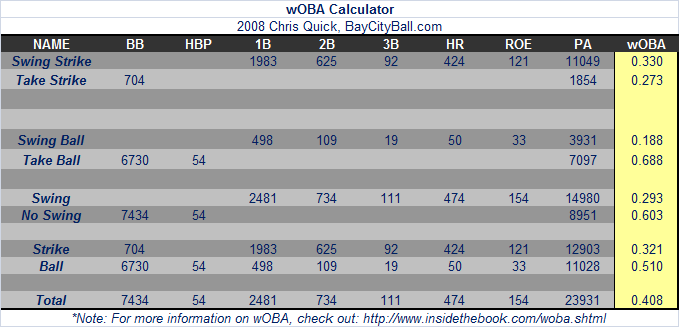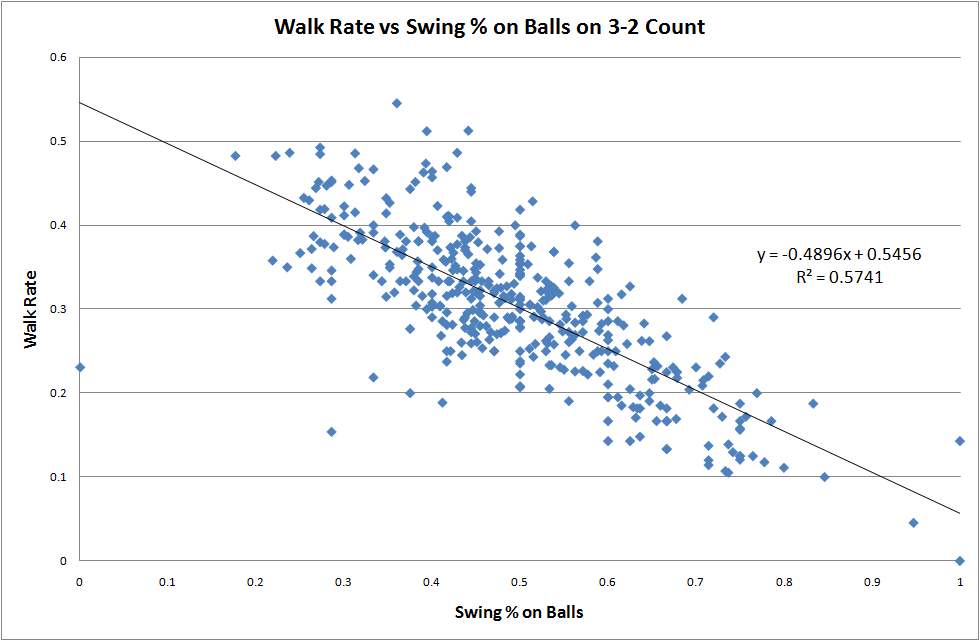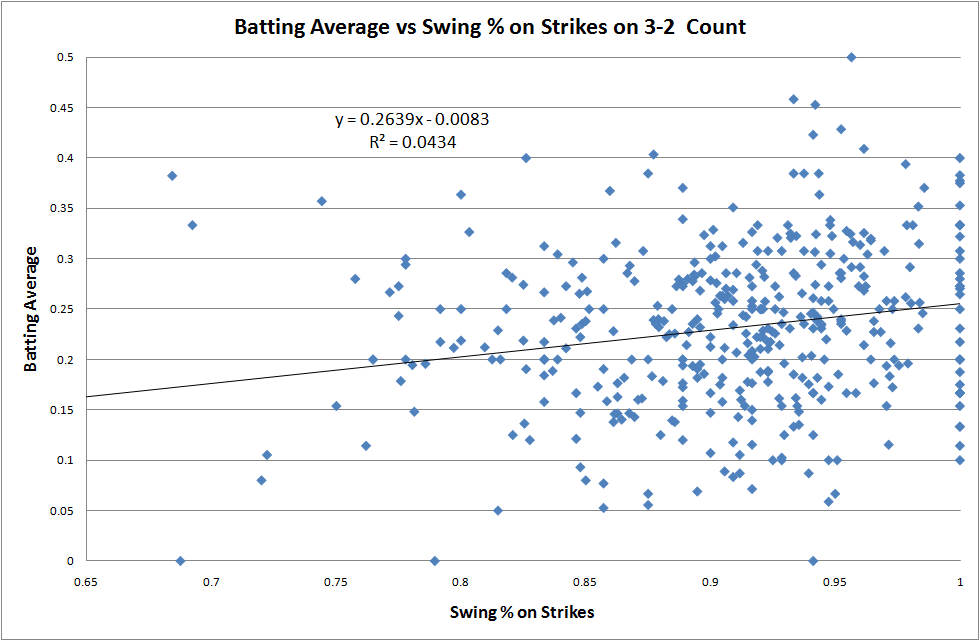Patience is a virtue (even on a 3-2 count)
One of my main goals, in researching baseball, is to identify situations in which batters are not performing to the best of their abilities. I’ve previously shown that batters are least selective on 3-2 counts. This means that they are swinging at more pitches, whether they are in the strike zone or not. It seems that in this situation batters try to maximize swings at strikes in order to protect the plate. Perhaps this seems like the right approach on the surface but I’m not so sure that it is. I think that the same attitudes which led to the undervaluation of walks and on-base percentage (pre-Moneyball) are still around and are causing batters to be less selective than they should be on full counts. Alternatively batters could be trying too hard to avoid strike outs (especially strike outs looking.) Whatever the cause, I believe that most batters are adopting a less productive approach on 3-2 than they are capable of.
For the purpose of this analysis I am using the Pitch f/x locations for pitches and sorting them into strikes (pitches which are in the strike zone when they cross the plate) and balls (pitches which are out of the strike zone). The umpire’s judgment of these pitches is something which I will factor in later, by looking at how the pitches were called when they were not swung at.
The best possible behavior, on a full count, would be to swing at every strike and not swing at any balls. Unfortunately batters don’t have the perceptive ability to do this. They are, therefore, faced with a trade-off. The more they swing at strikes the more balls they are also going to swing at. Let’s start out by examining their current behavior.

Batters swung at about 91 percent of strikes and 48 percent of balls on 3-2 counts in 2009. Pitchers threw a strike 59 percent of the time.
I haven’t decided the best way to account for foul balls in this analysis yet. We’ll see that foul balls are actually one of the more positive outcomes of swinging at a 3-2 pitch. This is because fouling off a 3-2 strike gives you the chance to get a ball on the next pitch. The way in which I am dealing with foul balls for this article is by looking at swing behavior on all 3-2 pitches (including the ones fouled off), but looking at results only for the last pitch of each at-bat. In the future, as the analysis becomes more structured I hope to come up with a more elegant way to deal with foul balls. The overall effect of foul balls is that on the final pitch of 3-2 at-bats pitchers threw 54 percent strikes. So batters do end up seeing more pitches outside of the strike zone due to their ability to foul pitches off.
To make any judgments about batting approach, we must look at the results of these at-bats. Below is the league-wide wOBA last season on 3-2 pitches. I have broken wOBA down by whether the pitch was in the strike zone and whether the batter swung or not.

We see that batters were well below average when they swung on a 3-2 count, generating a wOBA of .293 on these pitches. Their wOBA was over twice as high on pitches where they didn’t swing. To sum it up nicely: Batters actually made more outs on balls (3,535) than they reached base on strikes (3,245) on 3-2 counts in 2009!
There are a couple of interesting factors at play here when considering a change in batting approach. Umpires called over a third of pitches which were in the strike zone as ball four if the batter did not swing. This seems to be at odds with John Walsh’s excellent piece The Compassionate Umpire where he found that the strike zone is only slightly smaller than average on 3-2 counts. There is, however, another factor at play here. Batters are swinging at a LOT of pitches on this count. I believe this rate is so high because batters are swinging at everything except the most borderline strikes. The rate at which umpires issue a walk when the pitch is actually in the strike zone would surely decrease if batters swung less, but it’s hard to know exactly how quickly it will change. The same issue does not really exist with pitches outside of the zone as the overwhelming majority of pitches outside of the zone were called correctly.
Now that we’ve established the facts, let’s examine what might happen if batters changed their approach at the plate.

This chart shows the worst-case expected change in wOBA which the batter would get by not swinging at one additional pitch. I’ve broken it down by whether that pitch is in the zone or not. Since 60 percent of 3-2 pitches were strikes I weighted the strike value by .6 and the ball value by .4. The .330 wOBA value for strikes assumes that each additional strike which is not swung at will result in a strikeout, and that the batter will lose his average wOBA on that pitch. The value for an additional ball is the difference between the average wOBA achieved by not swinging at a ball and the average wOBA when swinging at a ball.
Even in this worst-case scenario, one in which batters are trading off swing percentage at balls for swing percentage at strikes at a 1:1 ratio, umpires are calling every additional pitch in the strike zone correctly, batters are losing their average wOBA on each additional strike taken and strikes are being thrown 60 percent of the time batters would STILL be slightly better off swinging less on 3-2.
My previous work on batting eye, umpire data and common sense all suggest that batters would increase their productivity more than this worst-case scenario predicts by changing their behavior. After all, batters should be able to adjust their swings at a better ratio than 1:1, umpires will still call some strikes as balls and the batter will not be laying off of the average 3-2 strike, they will be laying off of borderline pitches (which should lead to less of a loss in wOBA). If you use the marginal numbers instead of the worst-case numbers, the increase in expected value is much higher.

Even keeping the 1:1 ratio of swing percentage change, batters improve their productivity significantly when you examine the marginal numbers. To put it simply: Not swinging at a ball on 3-2 is far more productive than swinging at a strike is. When batters try to maximize their rate of swinging at strikes, they are taking the wrong approach. What they should be doing is trying to minimize their rate of swinging at balls.
I thought this analysis might be easier to understand by looking at one batter. I’ve done a write-up of Victor Martinez’s swing behavior and results over at my site. Go check it out, I think it’s a nice addendum to this research.
Another way to help demonstrate the impact of a batter’s 3-2 approach is by looking at some correlations based on individual batter’s swing behavior. Specifically, I am going to look at the impact that swing rate at strikes has on batting average and the impact that swing rate at balls has on walk rate.

We see here a very strong link between swinging at 3-2 balls and walk rate (which should have been pretty obvious). Put simply, as you lay off of more balls, you reliably increase your chances of taking a walk. Remember that in this data, we are looking at all 3-2 pitches, including the ones which were fouled off.
The second half of the trade-off is batting average. Will a batter get more hits by swinging at more 3-2 strikes? Will it be enough to make up for the walks which you lose by swinging at more balls?

Once again see a trend, but it is almost completely drowned out by noise. Only 5 percent of the variability in batting average can be explained by looking at the amount of 3-2 strikes which the batter swung at. The slope of the best fit line is also much smaller here than in the walk rate correlation. A similar pattern exists if you look at slugging percentage (with a slightly higher slope but an even lower R-squared value).
If batters were to swing a little less on 3-2, there would most likely not be much of a change in batting average or slugging percentage. There would, however, be a reliable increase in walks. There is more work to be done on the specifics, but I believe that these numbers begin to tell a very interesting story. Whether it is due to fear of striking out looking or undervaluing a walk, batters are too aggressive on full counts. Becoming more patient at the plate might cost the batter a few hits, but it will increase his overall productivity.

Craig,
Interesting piece and thanks for all the research. I have only a couple of quibbles, one of which is this: Your conclusion seems to be based on the assumption that the percentage of strikes/balls thrown will remain static if batter swing a little less. That may be true but it may also be the case that as batters swing less, pitchers will throw a greater percentage of strikes.
I also have a suggestion. You speculated that the reason batters swing more in 3-2 counts is that they fear of striking out looking and/or undervalue a walk. To sort out the role of each factor, you could compare the swing percentage at 3-2 to the swing percentage at 0-2, 1-2 and 2-2 and them to 3-0 and 3-1.
With two strikes but fewer than two balls the fear of striking out looking is present but the value of taking a pitch to achieve a walk is less. With three balls and less than two strikes the fear of striking out looking is less and the value of taking a pitch to draw a walk is greater.
Thanks Jonathan!
Pitching strategy is definitely something which I am going to build into my model as I flesh it out more. I think the overall strategy would stay the same – as the pitcher ‘throws more strikes’ they are going to throw more hittable pitches which should increase your productivity on swings.
So I’m definitely considering it – I just didn’t have the time to fully do it yet or the space to present it in this article.
Good work on this, I’ve noticed over the years many times where batters seem to lay off 2-2 balls only to swing at worse pitches on 3-2.
One issue you might want to adjust for is batters protecting runners the manager has set in motion. Batters are obviously going to be highly adverse to taking into a strike-‘em-out throw-‘em-out double play, and the tactic is common enough that it might affect the overall swing rates. I doubt the general trend will disappear but eliminating the offending base/out states might push the “never swing” option into the red.
James,
That’s a really good point. I should try to account for runners on base at some point.
Strategically speaking, I think you’re going to see a rise in 2-strike foul balls in the next decade as hitters begin learning the benefits of how to effectively INTENTIONALLY foul-off pitches. Combine this with diminishing foul territory in most the new stadiums, be on the look out for savvy hitters actually increasing the number of pitches they hit foul with two-strikes on them to the goals of drawing walks and raising pitch counts versus risking being put-out on a ball in play.